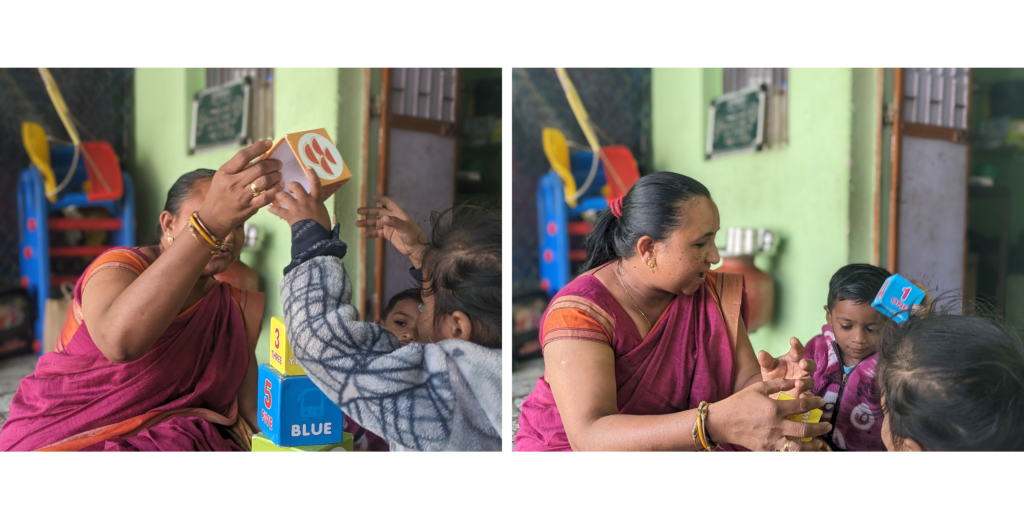In our podcast episode, with Dr. Ashwini Deshpande, she discussed a prevalent issue in developing countries like India: the concept of the “sticky floor.” It indicates a higher wage gap between men and women in lower work orders. The sticky floor creates invisible barriers for women, restricting them to advance beyond lower rungs of work. These barriers, such as unpaid household responsibilities, care work, and cultural norms, disproportionately burden women, leaving them with less time and energy to pursue livelihood opportunities. According to the ILO report on “care work and care jobs for the future of decent work”, unpaid care work is the main factor preventing women from getting into, remaining and progressing in the workforce.

“In the early stages of our work with women farmers in Kheda, we witnessed how some brought their young children to the fields, due to the lack of childcare support at home. Fields, particularly tobacco fields, were certainly not suitable environments for young children,” recounts Jayaben, a senior leader of the SEWA Cooperative Federation. With the support of SEWA, members of the Kheda cooperative began discussing the necessity of childcare during their meetings, thus giving rise to the idea of Shaishav and Sangini childcare centers.
How has this access to childcare, through cooperatives, affected women? We spoke to some members: “Pehla hun pachas rupaya nu kaam karti thi have 200 rupaya nu kaam kari shakun chun,” which translates to “Earlier I used to work for 50 rupees a day now I can work and earn for 200 rupees a day,” expressed one parent
“Jab se bacha aane laga hai idhar, tabse machine par bethne lagi hui,” meaning “Since my child has joined the Sangini cooperative, I am able to sit on the sewing machine and work,” said another parent
“300 rupees mein bohot faida hai – yahan khana bhi khata hai aur humein tension bhi nahi hoti,” conveying, “There are a lot of benefits in 300 rupees that we pay to the childcare center. My child gets food also here and I don’t have to worry about the child,” mentioned a third parent
Sangini childcare centers in Gujarat have evolved into one-stop spaces, now offering immunization services as well. With 13 centers spread across the state, each catering to an average of 30 children, these centers operate from 9:30 am to 5 pm, aligning with the schedules of working parents. Padma ben, the Manager of the Sangini cooperative, highlights the vital role of these centers in providing comprehensive support to women and their families. She emphasizes, “We have incorporated the concept of parents’ meeting. Earlier, there was just 30 percent participation of fathers, but now it has increased to 80%.” This inclusive approach not only addresses childcare needs but also fosters community engagement and supports educational transitions for children.
Every year, the Sangini Center hosts a graduation ceremony for children who are turning six and are ready to move to class 1, marking the beginning of their formal school education. Additionally, the center also provides them with a certificate, which proves to be a very important certificate for migrant families as it enables them to secure school admissions for their children.
In Ahmedabad’s Rameshwar Colony, one such Sangini center has been running for several years. Run by two women, Kajal Ben and Sumitra Ben, the childcare center accommodates 25 to 30 children. From morning prayers, to writing alphabets and learning the numbers, the children engage in various activities here. Ramila Ben, from the Sangini center, adds, “The children graduating from these centers often come back and drop their younger siblings here, recounting memories from these centers.”
Childcare centers, however, come with costs. From securing suitable spaces, especially in urban areas, to providing quality meals and training childcare staff, every aspect requires financial support. These centers must align their operating hours with the working hours of mothers, typically spanning 8 to 10 hours, necessitating an increase in staff members based on the number of children enrolled. In Sangini’s history, SEWA provided financial support for three years until they achieved self-sufficiency.
It is hard to be sustainable when the cost per child, per month is Rs. 1000, but the cooperative only takes a Rs. 300 fee from parents. This is because the children come from low-income families. “As a society, we have a responsibility. These are our children. These women are contributing to nation-building and to the nation’s economy,” says Miraiben, Chairperson, SEWA Cooperative Federation and Director, SEWA Social Security
The Sangini cooperative has evolved into a holistic center at the community level. It has provided women the time and space to focus on their livelihoods and increase their income levels. When students from Sangini transition to school, they exhibit confidence, often assuming leadership roles like class monitors, as observed by Padma ben. These centers have also relieved older siblings, typically daughters, of their caregiving responsibilities, enabling them to pursue their own education. Additionally, by offering employment opportunities to members, these centers contribute to local economic growth. However, ensuring their sustainability is crucial. These centers serve as a pathway for women to break free from socioeconomic constraints and leave the sticky floor behind.
By Rachna Chandira

